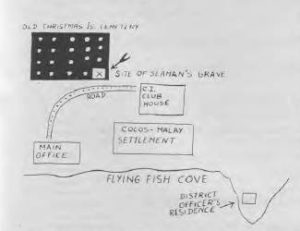- Author
- Clark, Bryan
- Subjects
- History - WW2
- Tags
-
- RAN Ships
- HMAS Sydney II
- Publication
- December 1989 edition of the Naval Historical Review (all rights reserved)
Writing again on March 2, 1988, Mr Taggart added: “The extensive research referred to was only to establish the positive location and identity of the grave concerned. This Office will not be initiating any further enquiry.”

The senior librarian and information officer, G. T. Proctor, of BHP Steel (ancestor company of Lysaght), Port Kembla, NSW, responded:
“Your letter concerning information on a Carley life raft was passed on to me for reply. Unfortunately, there is little help we can give that is positive. Our company, formerly John Lysaght (Australia) Limited, was involved in 24 wartime projects, but Carley floats was not one of them. Although the company manufactured a sheet steel with an annealed zinc coating, it was called Zincanneal and we cannot find Duaanneal listed as a trade mark for annealed zinc coated steel.”
“In constructing the life raft, a manufacturer could very easily have used our product, but we cannot confirm this as we have no sales records to check.”
UK author, Michael Montgomery: “I… thoroughly approve Keith Hasleby’s idea of a re-burial. I might drop him a line to that effect, as well as informing him that the original suggestion came from me (in 1981) and not Barbara Winter!”
Queensland naval research-author, Barbara Winter, in 1988: “Michael Montgomery is correct that he was the first person to publish a call for its re-burial. I have never claimed that I was… However, I had written it before Michael Montgomery’s book was published, though I probably cannot prove that. Actually, I care less than it may seem.”
“It is only a matter of sentiment. I think it would be impossible to attach a name to the body, as I doubt that dental records would be retained more than 45 years after a person was reported dead. I think it might even not be a good thing if it could be given a name. But I think it really should be recognised that the body definitely came from Sydney. To me, THAT is the important thing.”
“What should jump up and hit people on the head is this: there was NO OTHER SHIP from which it (the body) could possibly have come. Public servants handling this matter seem to have been concerned mainly with dodging anything which would make them think or work… So far, all anyone has done is bleat that they don’t think it came from Sydney. The road to Hell is paved not only with good intentions, but with ‘thinks’ and ‘don’t thinks’ not based on evidence…”
Commander Patrick Burnett (now retired, son of Captain Joseph Burnett): “…The official conclusion is open to question… If it (the corpse and Carley Float) was not from Sydney, from where did it come from? I imagine it will continue to be a matter of speculation.”
RAN Public Relations Officer (W.A.), Vic Jeffery, writing on December 9, 1988:
“With regard to HMAS Sydney there is only one file held in our headquarters registry. It is still classified as ‘secret’… There is nothing sinister about this file. The only reason it’s still ‘secret’ is the fact that its classification of 47 years ago has never been altered. As you can appreciate, I have studied it very closely looking for a clue or snippet which someone may have missed. All to no avail, I am afraid. There is… no mention of the incident of an unidentified seamen’s body being washed ashore …on Christmas Island….
Christmas Island’s administrator, Mr Don Taylor, writing in 1988-89, noted:
“Unfortunately, this is an episode which remains one of Christmas Island’s mysteries. To our knowledge, no copy of the inquest is on the Island, although searches have been conducted in the past. On the matter of the headstone, an early photograph (not very clear) shows the headstone intact in the background. The writing is not discernible. There is no information about who initially supplied the headstone, nor as to the words recorded on its surface. A local heritage enthusiast… has informed me that the headstone has always been missing, as far as he can remember, since 1970… If you have any better success than we have had, we would appreciate your passing on the details… I agree it is most unusual that the headstone would have disappeared altogether. However, (I have ascertained) it was not in existence from as far back as 1966…”




